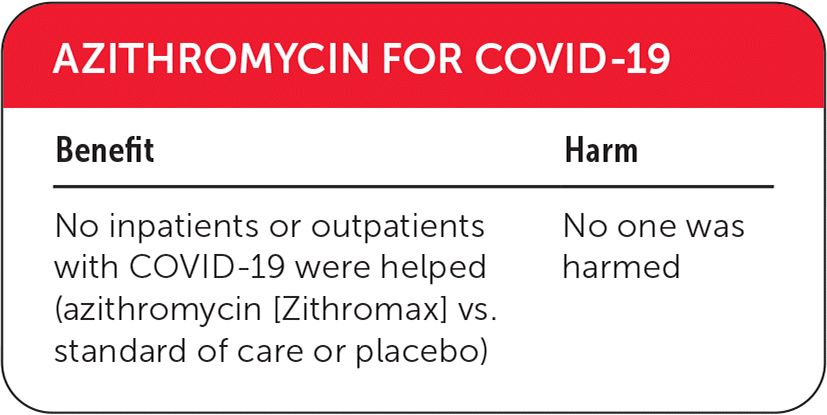
Am Fam Physician. 2022;105(3):online
Author disclosure: No relevant financial relationships.

Details for This Review
Study Population: 9,049 patients hospitalized with COVID-19 (inpatient setting) and 1,917 patients not hospitalized with COVID-19 (outpatient setting)
Efficacy End Points: For patients who were hospitalized: all-cause mortality, clinical status (worsening or improvement), and death within 28 days of diagnosis; for patients not hospitalized: all-cause mortality, hospital admission, death within 28 days of diagnosis, and symptom resolution within 14 days
Harm End Points: Any adverse events and serious adverse events

| Benefit | Harm |
|---|---|
| No inpatients or outpatients with COVID-19 were helped (azithromycin [Zithromax] vs. standard of care or placebo) | No one was harmed |
Narrative: COVID-19 is a rapidly spreading disease that has resulted in more than 400 million cases and more than 5.7 million deaths worldwide as of February 10, 2022.1 Although most patients have mild symptoms and do not require hospitalization, some develop severe or critical disease requiring hospital admission, oxygenation, and ventilatory support.2–5 Vaccination has proven to be effective at reducing transmission, severe illness, and death, but vaccine hesitancy and unequal access to vaccinations pose significant global threats.6,7 Several therapies have been proposed for inpatient and outpatient treatment of COVID-19, including antibiotics such as azithromycin (Zithromax).
A Cochrane review including 10 randomized controlled trials (RCTs) evaluated azithromycin vs. standard of care or placebo in 10,966 inpatients with moderate to severe COVID-19 or outpatients with asymptomatic or mild COVID-19.8 Patients with suspected or confirmed COVID-19 (using polymerase chain reaction or antigen testing) were enrolled in these trials. Among inpatients, primary outcomes included all-cause mortality, clinical status (worsening or improvement), death within 28 days, any adverse events, and serious adverse events. Among outpatients, primary outcomes included all-cause mortality, hospitalization, death within 28 days, symptom resolution within 14 days, adverse events, and serious adverse events. Azithromycin dosages included the usual dose (250 mg to 500 mg orally once per day; 500 mg intravenously once per day), low dose (less than 250 mg orally once per day; less than 500 mg intravenously once per day), or high dose (greater than 500 mg orally once per day; greater than 500 mg intravenously once per day). Standard-of-care and placebo arms were considered the control groups. The Cochrane review excluded studies that compared antibiotics with other treatments.
The meta-analysis included seven RCTs with 9,049 inpatients who had moderate to severe COVID-19 and three RCTs with 1,917 ambulatory outpatients who had asymptomatic or mild COVID-19.8 In the outpatient setting, all medications were administered orally. In the inpatient setting, medications were administered orally, intravenously, or by nasogastric tube.
Compared with standard of care alone, azithromycin in the inpatient setting did not affect all-cause mortality within 28 days (high-certainty evidence) or any adverse events (low-certainty evidence). Compared with standard of care or placebo, azithromycin in the inpatient setting did not affect clinical worsening or death within 28 days (moderate-certainty evidence), clinical improvement within 28 days (moderate-certainty evidence), serious adverse events (moderate-certainty evidence), or cardiac arrhythmias (moderate-certainty evidence).
Compared with standard of care or placebo, azithromycin in the outpatient setting did not affect all-cause mortality within 28 days (low-certainty evidence), inpatient admission within 28 days, death within 28 days (low-certainty evidence), or symptom resolution within 14 days (low-certainty evidence). There was no difference in serious adverse events compared with placebo or standard of care (very low-certainty evidence), and no study reported adverse events or cardiac arrhythmias.
Caveats: This meta-analysis had limitations. Most of the patients who were hospitalized with COVID-19 had moderate disease. The sample size for patients with severe disease was small. Several trials included patients with suspected, but not confirmed, COVID-19. Although the evidence for inpatients demonstrated a high certainty of evidence and low risk of bias, only three RCTs of outpatients were included, with a relatively small number of patients having confirmed COVID-19. For total and serious adverse events, there was a high risk of bias and imprecision of results due to the limited number of studies reporting adverse events, and most of the studies were underpowered to adequately address harm outcomes.
Conclusion: The Cochrane review summarized here found that azithromycin did not reduce mortality or improve clinical outcomes in patients with COVID-19 in the inpatient or outpatient setting compared with standard of care or placebo. These findings are consistent with results from guideline recommendations and other meta-analyses.9,10 Based on this evidence, we have assigned a color recommendation of red (no benefits) for the use of azithromycin in patients with COVID-19 in the inpatient or outpatient setting.
